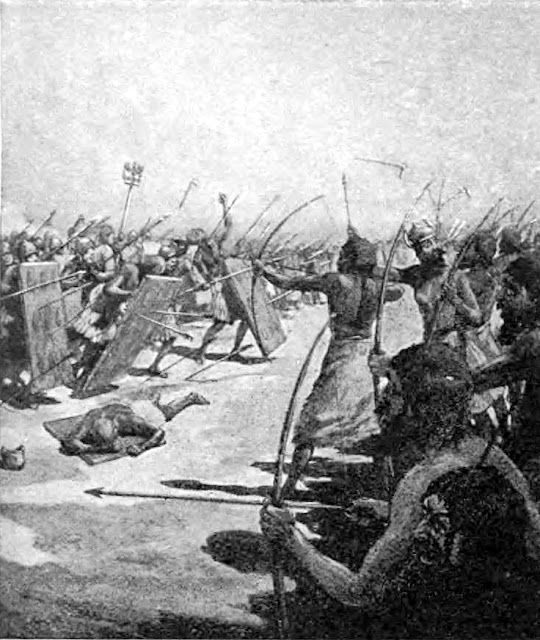Establishing an empire is one thing, maintaining it is another. This beset the successors of Sargon the Great after their patriarch passed away, living them with history's earliest known empire. Unprecedented, Sargon's sons and grandson worked extremely hard to follow a tough act.
1. Rimush (r. circa 2,279 - 2,270 BCE)
Rimush began a tradition that will meet every new Akkadian ruler upon ascension - suppressing rebellions. Apparently, the spirit of independence among the Sumerians and other subjugated countries of Sargon lingered. Even before the end of founder's reign, some city-states already began to stand up against Akkadian imperialism. When the Akkadian leader fell, the conquered saw an opportunity to rise up. It then became a baptismal of fire for every new Akkadian king, testing their martial prowess and proving their qualification to rule a vast multi-ethnic Empire. Rimush unfortunately added his own brutal twist that many future Akkadian rulers followed as an example.
Sargon's son left inscriptions celebrating his military campaigns and boasting the number of casualties he inflicted upon his enemies. The cities of Adab and Zabal experienced Rimush's wrath.
"Rimush, King of the World, was victorious over Adab and Zabala in battle and struck down 15,718 captives. Further he captured Meskigala, Governor of Adab, and Lugalgalzu, Governor of Zabala. He conquered their 2 cities and destroyed the walls of both of them. Further, he expelled many men from their 2 cities and annihilated them."
Thus, the Akkadians began the policy of mass deportation towards the defeated. A practice emulated by the later Assyrians and Babylonians. On the other side, the Israelites became as a famous example of victim of the practice under Babylon.
Forced migration, enslavement, and complete annihilation of cities became Rimush's instrument to instill fear among his subjects, nevertheless, many continued to resist. Rimush defeated more Sumerian city states such as Ur, led by King Kaku, Umma, and Lagash. The Elamites also rebelled against the Akkadian Empire and gained support from various countries including the far off Meluhha, which suspected to be located in the Indus Valley. Rimush crushed the rebel coalition in the Battle of the Middle River around 2,273 BCE.
“Rimush, King of the world, was victorious in battle over Abalgamash, King of Parahshum. Zahara, Elam [Gupin, and Meluhha,] had assembled in Parahshum for battle, but he Rimush was victorious over them and struck down 16,212 men and took 4,216 captives. Further, he captured Emahsini, king of Elam, and all the nobles of Elam. Further, he captured Siga’u, general of Parahshum, and Sargapi, general of Zahara, in between the cities of Awan and Susa, by the 'Middle River.' Further, he heaped up over them a burial mound in the are of the city. Further, he conquered the cities of Elam, destroyed their walls, and tore out the foundations of Parahshum from land of Elam. Thereby Rimush, king of the world, ruled Elam. The god Enlil showed him the way to victory… When he conquered Elam and Parahshum, he took away 30 minas (roughly a pound each) of gold, 3,600 minas of copper and 300 male and female slaves and dedicated them to the god of Enlil."
Around 2,270 BCE, due to unknown reasons, perhaps because of his ruthlessness, Rimush may have been assassinated in a coup. His brother Manishtusu came power, but whether his brother orchestrated the palace revolt or someone who staged a counter coup remained an open question.
2. Manishtusu (r. circa 2,270 - 2,255 BCE)
Manishtusu's (Manishtushu) followed the same narrative as his brother. His reign, however, accomplished distinguishable actions in contrast to his brother. Nevertheless, he followed the same faith as his predecessor.
Manishtusu, translated to "who is with him?", ascended after his brother, even suspected twin brother, fell to assassins. Just like his brother, insurrections erupted afterwards. He, however, managed to subdue them. Then, around 2,260 BCE, he embarked in an unprecedented naval expedition against Anshan and Shirishum along with 32 allied countries. An inscription stated:
"Manishtusu, king of the world: when he conquered Anshan and Shirishum (south-west Iran), had ships cross the Lower Sea. The cities across the Sea, 32, assembled for battle, but he was victorious over them. Further, he conquered their cities, struck down their rulers, and after he roused them his troops plundered as far as the Silver Mines. He quarried the black stone of the mountains across the Lower Sea, loaded it on ships, and moored the ships at the quay of Akkad. He fashioned a statue of himself and dedicated it to the god Enlil"
The black stones, called diorites, turned into obelisks and statues, such as the Manishtushu Obelisk now displayed in the Louvre. Besides an example of the King's exploits, it also showed his distribution of 4 parcel of lands to his officials.
Manishtushu also received the credit of rebuilding the Temple of Ishtar in Niniveh.
Ultimately, according to an omen, Manishtushu's reign came to an end after his assassination by courtiers using their cylinder seals. His fall led to the ascension of his son, Naram-sin, and the apex of Akkadian imperial power.
Bibliography:
Edwards, I.E.S. et. al. (eds.). The Cambridge Ancient History: Early History of the Middle East, Volume 1 Part 2. New York, New York: Cambridge University Press, 2006.
Hamblin, William. Warfare in the Ancient Near East: Holy Warriors at the Dawn of History. New York, New York: Routledge, 2007.
General Reference:
"Manishtusu." Who's Who in Ancient Near East. Edited by Gwendolyn Leick. New York, New York: Routledge, 1999.



.JPG)
.jpg)

No comments:
Post a Comment
Note: Only a member of this blog may post a comment.